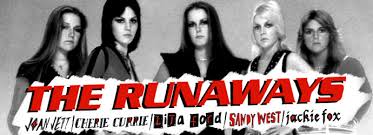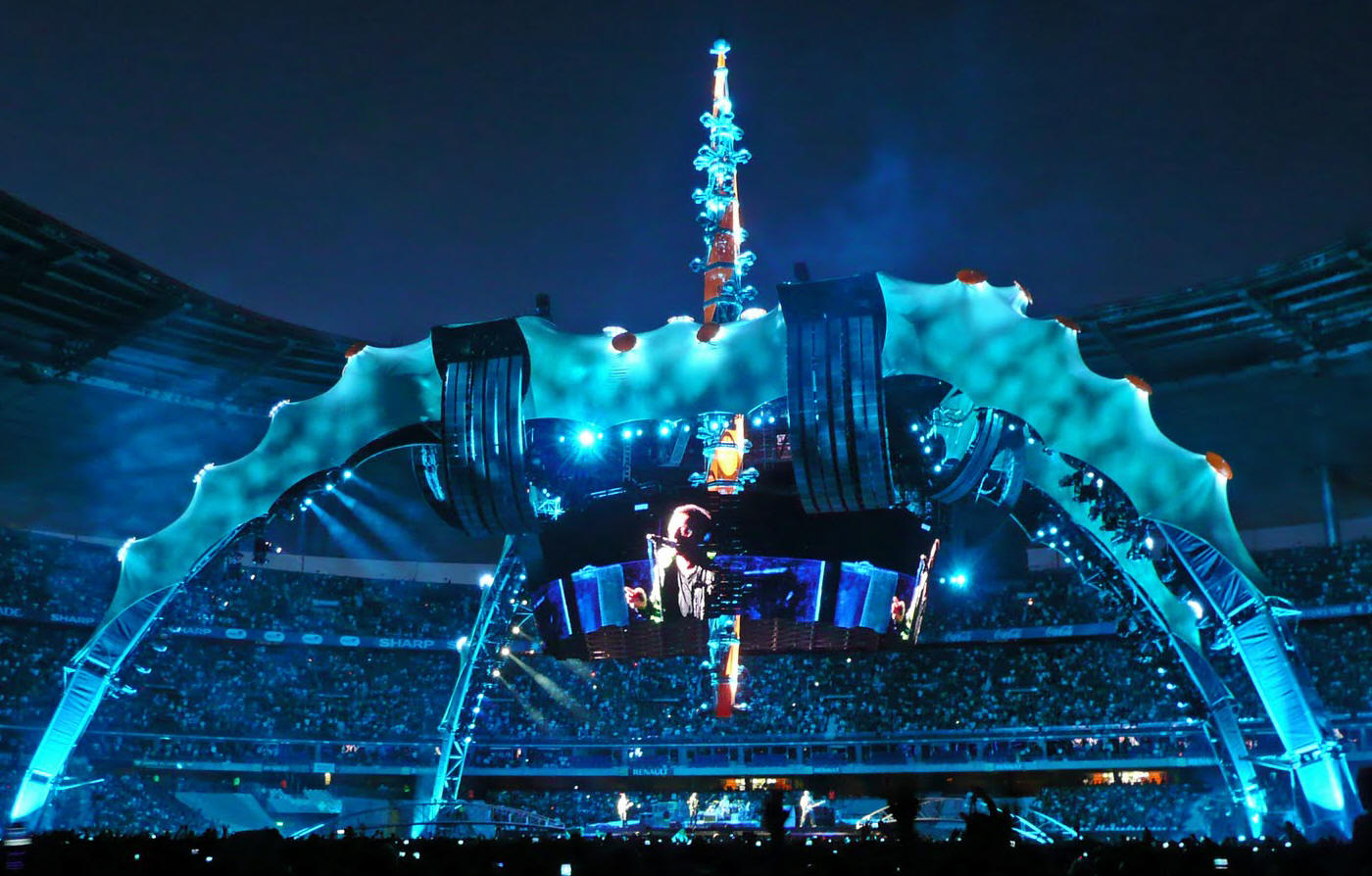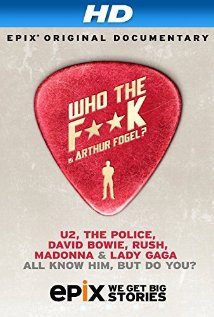
By RAR
A
couple months back, after Jackie Fuchs
published her Huffington Post account of being raped as a teenaged
member of the jail-bait act The Runaways,
I felt a revulsion similar to what I feel about watching violent
exploitation films. It wasn't just the Kim
Fowley rape story, in which Runaways
Joan Jett and Cherie Currie
allegedly watched their band mate being drugged and assaulted as an
entertainment spectacle, but it was the entire business of rock music
that seemed to be called into question, and it felt nauseating.
In truth, parents in the 1950s saw it
coming. When Alan "Moondog" Freed -
"Moondog" was a name he appropriated, and eventually had to pay a fee to
retain - got a tip from Cleveland record store owner
Leo Mintz that people were buying R&B
records, Freed started a midnight show on Cleveland station WJW (850 AM)
spinning what was then considered to be "race music", predominantly the
work of Black entertainers. Freed began cultivating a high-energy on-air
radio personality and in 1952 he organized what is generally considered
to be the first concert presentation of what Freed called "Rock and
Roll" music. Held at the Cleveland Arena, the show was shut down almost
as soon as it began because the venue was over-sold. People who bought
tickets couldn't get in, resulting in a riot that caused police to step
in and close the event before the first of the five scheduled acts had
hardly begun their opening set. The publicity created a frenzy of interest in
this new form of music, geared specifically to very young audiences, and Freed's radio show became a big hit. By 1954, Freed was out of Cleveland
and setting up shop in New York City. Rock'n Roll, as it would come to
be known, was going big time. The impresario Freed was on his way to
music legend, and to a payola scandal that would cap his
rise to fame.
Some parents, concerned with the effect
that the music that Freed championed might have on their children,
viewed Rock'n Roll with horror. This was a type of music that came along
in a post-World War II environment in which the era of the classy big bands was
going belly up. It would, in many respects, mark the end of that phase,
in the still relatively young radio music industry, in which the
spotlight would be on adult performers. Young people, with all of their
sexual energy, lack of real-world experience, and live-for-today
mentality, were moving front and center in the entertainment business,
and to the generation that had just fought a world war against fascism,
the new sounds were appalling. Mitch Miller, who was the head of
Columbia Records at the time, offered kitsch, like "How Much Is that
Doggy In the Window?", as an alternative, but young people were not into
singing along with Mitch. Rock'n Roll provided rebellious
counter-programming to the "white bread" standards of 1950s middle America. Pandora's box was opened and the reckless spirit of Rock was
unleashed upon a world that would never be the same again.
Exploitation has always been at the heart
of Rock'n Roll, which had a sleazy element at its core from the
beginning. Elvis Presley, with his hip gyrations that encouraged
television producers to censor his on-camera appearances, was an
innocent indicator of what the genre would eventually become. By the
second half of the 1960s, you had Jim Morrison
of The Doors charged with exposing
himself on stage, and by 1971 you had The
Rolling Stones releasing Sticky
Fingers, with its crotch-zippered cover. Youthful rebellion,
fired by the sexual revolution, had come to be symbolized by sexual
freedom and an entitled sense of unrestricted desire: sex, drugs, and
rock'n roll.
Lasciviousness ruled like a thumb-in-the-eye to staid moral conventions.
The creation of
The Runaways, an all-girl band established in 1975, was an
expression of the worst that those worried parents of the 1950s
could have possibly imagined. The band was built around sex and the
notion that the girls in the band, all teens at the time, were real-life
jail bait. They were "cherry bombs", in the words of one of their most
well-known songs. They were built to be exploited and to exploit, so
four decades later the story of Jackie Fuchs' (aka Jackie Fox) rape
story seems as natural and logical as the string of deaths by drug
overdose that became a standard of the rock music industry. These debasements were precisely what these entertainers were
designed to experience and represent. Within two decades, from the time
of its arrival, rock music had become a disease that young people
craved.
________________________
In the world of rock music
in the 21st Century, we are all figurative runaways, raped by a culture
that somehow got the wrong idea, took "sex, drugs and rock'n roll" as a
legitimate rallying cry, and were seduced into a world that is about as
real and holistic as the carnival sideshows that still trape through our
collective consciousness, admonishing us to "come and be amazed". The
result has been a cheapening of what it means to aspire to creative
heights through pop music, and to produce expressions that feed and nourish people, and
expand our understanding of what it means to be human. By all of this,
we are as victimized as the teenaged Jackie Fuchs, numbed into a
paralyzed state of awareness, screwed by predators who have somehow
convinced us that they are doing us a favor.

You mean Lady Gaga can
actually play?
A humorous side note to the Arthur Fogel
story (right). At one point in his documentary, Fogel talks about Lady
Gaga showing up at some benefit and performing solo on piano. Fogel
seems blown away by her actual ability to play the piano and sing. How
telling is that? Fogel had apparently assumed that she was just another
"act". Apparently acts these days are not suspected of being actual
musicians., which pretty much says it all about the state of affairs in
current pop music. |
 Showy
Exploitation Showy
Exploitation
Rock'n
roll, in its most elemental form, was an authentic musical
expression that could be staged anywhere from roller rinks
to public parks. In that sense, in its earliest stages it
was independent of the trappings of its pop music
predecessors. The Big Band Era was played out in hotel
ballrooms that offered an atmosphere of intimacy with
performers whose personal star power was secondary to the
music they produced. The early Rock years were played out in
small clubs, some of which, like the Whiskey A-Go-Go in L.A.
and the Cavern Club in Liverpool, became famous landmarks on
the cultural landscape. But as the genre grew in size and
intensity, impresarios like Bill Graham, in San Francisco,
began to stage concerts in larger auditoriums, like the
Fillmore and Winterland, and eventually in sports stadiums.
Big festivals, like Woodstock and the Monterey International
Pop Music Festival, began to emerge as important events in
the burgeoning rock music culture, and as those larger, less
intimate venues were developed, it became necessary to stage
music events in ways that could mitigate the loss of
intimacy and audience connection to the performers that had
always been so central to live music entertainment. A
special breed of impresario was needed to turn these large
venue events into spectacles. A documentary currently
showing on NetFlix features one of the most important
figures to emerge from this transition, the Canadian concert
producer Arthur Fogel.
Where earlier promoters -
most especially the Mafioso-like
Bill Graham - had been a highly visible
personality on the music scene, the new world of
stadium-sized events rendered the new breed of concert
producers, like Arthur Fogel, almost invisible. Thus we have
the title of the documentary that Fogel financed about
himself - "Who the F**k is Arthur Fogel?" - with its
requisite obscenity that has become the clichéd standard of
modern rock music. Obscenity has been the name of the game
in rock music since The Beach Boys stopped appearing in
fraternity gear and The Monkees left prime-time television.
Popular music became a vulgar expression, in which "flipping
the bird" and using foul language was de rigueur. Every rock
performer in the world now curses like a long shoreman, or
like Dave Grohl, of the Foo Fighters and formerly of
Nirvana, who seems incapable of uttering a single sentence
that does not include the word "fuck". In this way, he has
become a symbol of our new idiot culture; an avatar of a new
world order that hasn't got a "fucking clue" about what they
are doing to our society and culture. As incredible as it
may seem, the marginally-talented Dave Grohl is a role
model.
The more inane rock music
became, and the larger the venues in which it was presented
became, and the more necessary it became to present the form
as a spectacle. This has been Arthur Fogel's claim to fame.
His documentary traces his rise to imminence, first through
the production of The Rolling
Stones 1989 "Steel Wheels Tour", which did $170
million in concert ticket sales and changed the face of
big-time rock forever. Fogel has gone on to produce
enormously expensive touring spectacles for
U2, Madonna, Lady Gaga, The Police,
and David Bowie, among
other enormous acts, all dependent upon massive stage
designs and immersive audience experiences achieved
primarily through large video screens and stage props. The
spectacle form achieved its greatest scope to date with U2's
’s 360° Tour, which required a crew of
300 workers ($750,000 per day in salaries) to set up their
400-ton, 151-foot tall video and sound system, with set-up
costs between $23-$31 million for each of its 110 shows. In
the end, the tour became the highest grossing tour in music
history, with $730 million in gate receipts.
For these top acts, their
stage productions have become arguably more important than
their music. People pay hundreds of dollars for a single
seat at these mega-events, largely just to behold the
spectacle of extravagant excess. In the world of rock music
today, performers don't make much money from record sales,
but rather through their ability to sell tickets at enormous
prices. What may be
lost in all of this Las Vegas-style staging, which is the
purview of only the top acts in the world, is that the
incomes received from these shows is the reward of
entertainers whose best music work is typically more a part
of their legacies, than of their current viability as music
artists. The Rolling Stones, U2,
Madonna, and The Police
have not really done anything worth listening to
in years, sometimes decades. (In fact, the members of The
Police, who seem to hate each other personally, hadn't even
played together in a couple decades before reuniting for one
of these extravagantly expensive tours.) One could even
argue that Lady Gaga has never done anything worth
remembering at all. It doesn't matter in today's hyperbolic
spectacle environment, because the music is secondary to the
show, and the shows are huge. In fact, they are obscenely
huge; as huge as the prices people pay to see these events.
Rock music has become Las
Vegas spectacle, and one could be forgiven for wondering
what the impact of that has been on the quality of pop music
overall. As Bob Dylan famously said, "money doesn't talk, it
screams obscenities", and so it is almost impossible today
for new, possibly actual, artists to make themselves heard
and known over the din of these corporate-style sensory
assaults. The
extravaganzas have also had an effect on audiences, who seem
to have jettisoned any connection they may have ever felt to
"blue collar" recording artists, swept aside by the
spectacle of the Las Vegas-style presentations.
It is as if the entire rock
music world has morphed into versions of old, fat Elvis
Presley in his glittery Vegas jump suits. It is difficult to
assess exactly what that means to western culture, but one
senses that it isn't good. - RAR |
